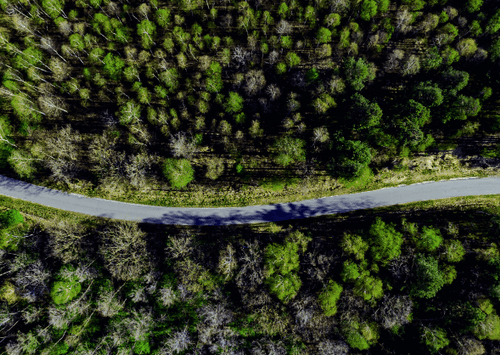
The Fight For Legacy Forests: Part Two – Why & How DNR Manages Forest Land
Listen
In the 2nd of her 8-part series “The Fight For Legacy Forests”, NWPB’s Lauren Gallup looks at why and how the DNR manages state forests / Runtime – 6:10
Read
Before we get too into the weeds on recent opposition to timber sales and legal battles being fought against the Washington Department of Natural Resources, it’s important to understand how and why the DNR does timber harvests.
The DNR is entrusted with managing 3 million acres of trust lands. The lands came from the federal Omnibus Enabling Act of 1889, which granted the state millions of acres of land to support public institutions, according to the DNR’s website.
According to the website, the lands are managed to produce non-tax revenue for specific beneficiaries. There are eight major trusts. They benefit K-12 schools, counties and junior taxing districts, universities and institutions managed by the state departments of Corrections and Social and Health Services. The largest share of this land is for the K-12 Common School trust, 1.8 million acres.
How do the beneficiaries benefit though? Much of the entrusted land is forested, and the DNR holds public auctions for timber harvests on the trust lands. The revenue then goes to the trust beneficiaries.
NWPB spoke with Duane Emmons, product sales and leasing division manager for the DNR, about the step-by-step process the department goes through to prepare timber sales on trust lands.
Emmons says the DNR works under the overarching umbrella of management based on policy, including the state’s Forest Practices Act and the federal Endangered Species Act. We’ll talk in later stories about some of the guiding policies behind the DNR’s work and how the interpretations of these are being considered in court.
Emmons says that at the beginning of planning a timber sale, the department reviews these policies and procedures, “to make sure that we’re implementing those broader policies and those regulations correctly.”
Every decade, the department sets a Sustainable Harvest Volume, looking 100 years out to what would be considered a sustainable level of harvest on the trust. With this, they set the sustainable harvest level for the decade. Emmons says the department produces a full environmental impact statement at this time.
The department does a quarterly economic revenue forecast, based on meeting the level set in the Sustainable Harvest Calculation. The most recent one was completed at the beginning of March.
According to the DNR’s website, “timber revenues for the 2021-23 biennium are $371 million — around 4 percent higher than previously forecast. Forecast revenues for the 2023-25 biennium are increased to $353 million — around 3 percent higher.”
The economic forecast acknowledges a proposal to limit harvest to stands less than 120 years old, the potential moratorium on stands that predate 1900 that the Board of Natural Resources is currently reviewing. This would remove 15 to 20 million board feet of timber from the 2022 fiscal year proposed sales, according to the economic forecast.
The most recent sustainable harvest level was set in 2019, four years into the decade it was for, as the department completed the marbled murrelet strategy amendment to the Habitat Conservation Plan — one of the guiding policies we’ll discuss in further detail in later stories. For a quick summary, the HCP sets guidance on how the department will manage its land in cooperation with the federal Endangered Species Act. This can mean some of the land DNR manages is conserved for species preservation.
“Now that we have those areas that we’ve identified that are able to be operated on, what our staff will do is they will look at a five year plan. And so, five years out, we’re looking at what areas we’re going to be potentially moving through and looking to set up harvests,” Emmons says.
This is strategic planning of general areas to harvest, and as an individual timber sale gets closer, Emmons says the preplanning work can take between one and two years.
Based on the sustainable harvest level, they know which lands are available for harvest. Foresters then do a desk review of the specific area for sale, Emmons says. Using geographic information system mapping, or GIS, they identify any potential wetlands, streams, unstable slopes, rare and or threatened species, so then specialists can do further review.
Field staff then do what Emmons calls the “boots on the ground” work, measuring out for any necessary buffers, identifying resources that need to be protected and which minimum of eight trees will be left per acre. The department scopes out a plan to submit for a Forest Practices permit, as well as a State Environmental Policy Act or “SEPA” checklist.
The public is allowed to comment on the SEPA checklist, Emmons says.
“Once that sale has been laid out, so there are really three areas of demand selected, unstable slopes, special sites, sensitive sites and protected, we’ve identified where we’re going to leave our minimum of eight trees per acre out on the landscape. Once all of that fieldwork is done, we then at the same time are developing the contract for each of the sales,” Emmons says.
All timber sales are done through public auction, and most contracts for timber sales require the purchaser to complete all actions in two years.
“We hand over the burden to them of making sure that they’re complying with the Forest Practices application, if they violate that, then they are going to be, you know, receiving penalties or corrective action from the Forest Practices, regulatory division,” Emmons says.
Emmons says throughout the process, the department has contract administrators on the sales to make sure the contract requirements are being followed.
The Board of Natural Resources makes policies for the department, Emmons says. The BNR is composed of six members; public lands commissioner Hilary Franz, Clallam County Commissioner Bill Peach, Washington State Superintendent of Public Instruction Chris Reykdahl, Washington State University’s Richard Koenig, designee for the governor’s office Jim Cahill and the University of Washington’s Dan Brown.
The BNR acts as the board of appraisers for timber sales, setting the minimum bid for the sale and ultimately approving the sales at monthly board meetings. The board has the opportunity to ask further questions of the department as they decide whether or not to approve a sale.
We’ll talk more about the review the BNR is taking of stands predating 1900 in later stories, and how this is a response to community concerns. Some timber sales have recently been put on pause because of this. At the March BNR meeting, the board unanimously approved all three proposed timber sales.
I’m Lauren Gallup, join us next time to learn more about the supreme court case currently being decided that seeks to clarify interpretation of land management by the DNR as laid out in the state’s constitution.
Related Stories:

The Fight For Legacy Forests – Part One: Defining What Should Be Preserved
A battle is raging over how the DNR is managing and selling logging rights to state forest lands Listen NWPB reporter Lauren Gallup introduces us to her 8-part series on
















